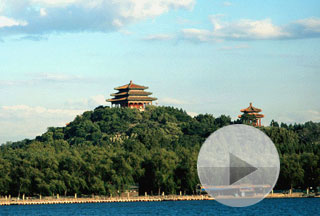Source: CCTV.com
08-07-2008 16:01
 |
| Watch Video >> |
Jingshan Park, an former imperial garden, lies to the east of Beihai Park. It occupies an area of 23 hectares. Many palatial towers and pavilions are arranged on a 47.5-meter-high hill.
In 1179 Emperor Shi Zu of the Jin Dynasty stored here the earth removed from the construction site of Taining Palace. During the Yuan Dynasty the mount was enclosed in the wall of the palace. In 1421 the emperor of the Ming Dynasty began to rebuild Beijing as the national capital. The debris of the torn-down old palace and the earth dredged from the moat were dumped upon the earthern mount. Trees were planted and some buildings erected. The mount was named the Hill of 10,000 Years and became an imperial garden to the north of the imperial Palace. In 1644 a peasant uprising army led by Li Zicheng took Beijing. Emperor Chong Zhen fled to Jingshan and hanged himeself on a Chinese scholartree.
The name of "Jingshan" was given in 1655 during the Qing Dynasty. In 1751 five pavilions were built on the hill in a straight line. Wanchun Pavilion in the middle is on the central axis of the old Beijing city. From there one has a grand view of the former Imperial Palace.
Jingshan Park has many ancient trees and stretches of peony flowers. It is today a favorite tourist spot.
Editor:Liu Fang
